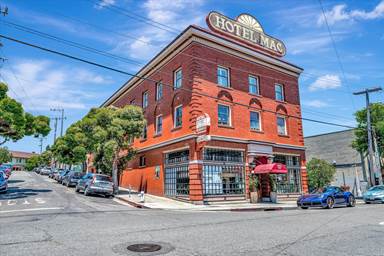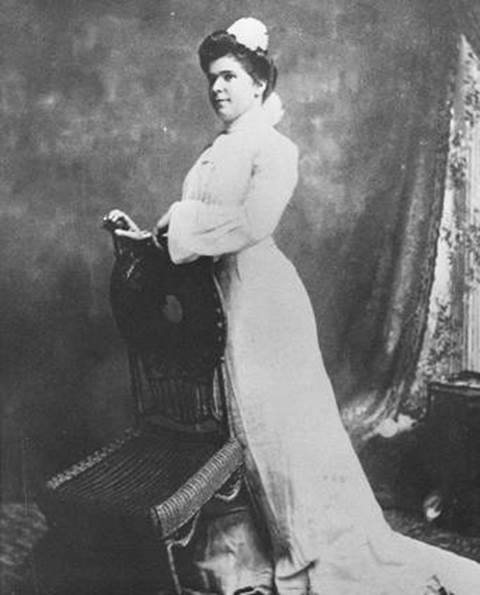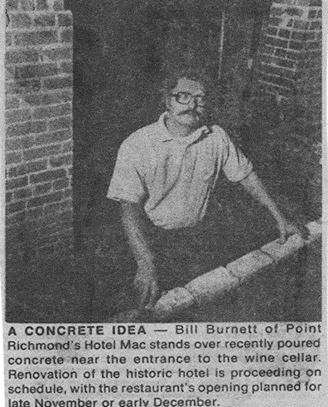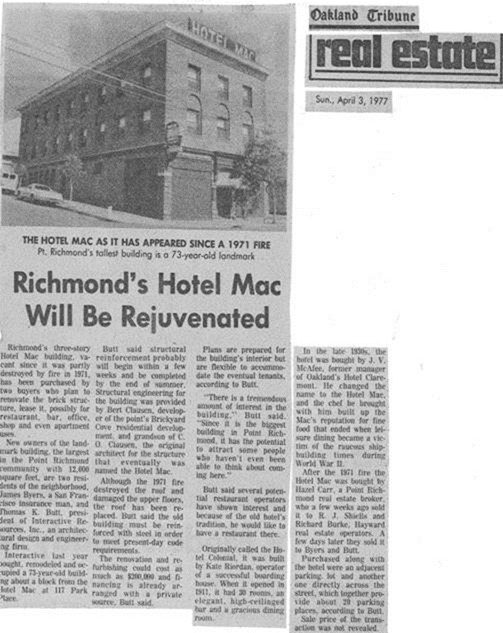|
|  
Richmond’s iconic Hotel Mac building, along with three other nearby properties that expand its lodging accommodations, is for sale for $2,400,000. For a full presentation, see https://50washingtonavenue1813542mls.f8re.com/Website/Index#VIDEOS. The Hotel Mac was built is 1911 and rehabilitated in 1978. Its rehabilitation sparked a general renaissance of the Point Richmond commercial district, and its restaurant, currently Biancoverde, set a high standard for Richmond culinary offerings. The restaurant business, which has had three owners since 1978, has been the venue for some of Richmond’s most important political deals and intrigues over the years. The details of the $90 million Chevron ECIA (Environmental and Community Investment Agreement) were hammered out in multiple Hotel Mac Wine Cellar dinners accompanied by plenty of wine.
Following is a history of the Hotel Mac and its rehabilitation:
In 1977, the iconic Hotel Mac in Point Richmond was a partially burned-out shell and was the subject of a foreclosure sale.
A Point Richmond neighbor, Jim Byers, approached me about collaborating in the purchase and rehabilitation of the Hotel Mac. He had the money, and I had the architectural knowledge to get it done.
We attended the foreclosure sale on the Contra Costa County Courthouse steps in Martinez. The bidding began at about $37,000. There was one other bidder. When the bids got up to $39,000, Byers told me, “Were done. Let him have it. He’ll call us to unload it.”
Byers was right. A couple of days later, we got the call and bought the building from the successful bidder for $43,000.
As we started planning for rehabilitation, I wanted to use a new tax incentive for rehabilitation of historic structures, but the property had to be on the National Register of Historic Places to qualify. Checking with the State Office of Historic Preservation, I was advised that the building was not significant enough to qualify individually for the National Register, but as part of a historic district, it could benefit from the tax incentives.
A little more research revealed that, as part of the environmental review for the beginning of what is now I-580, Caltrans had completed an evaluation of Point Richmond as a historic district and found it eligible for the National Register. All we had to do was complete the documentation and submit a formal nomination.
I enlisted Lucretia Edwards and some other volunteers, and we completed the project and submitted the successful nomination. The Point Richmond Historic District was entered in the National Register of Historic Places in 1978.
Formal nomination of the Point Richmond Historic District to the National Register is expected by the end of this month, according to Thomas Butt of the Point Richmond History Association. Processing of the application is expected to take several months.[1]
History of the Hotel Mac
The Hotel Mac, originally the Colonial Hotel, was constructed in 1911 by entrepreneur Kate Riordan, an Irish immigrant, who had been running the St. James Hotel on Cottage Avenue after fleeing San Francisco following the 1906 earthquake. Richmond was in a growth spurt at the time, and hotels, restaurants, bars and boarding houses were in demand by refinery and railroad employees.
The architect was C.O Clausen, uncle of Richmond engineer Bert Clausen, and the construction cost was $25,000. The hotel had 30 rooms, typically small and intended for single men.
Although the 20th Amendment was not passed until 1920, California adopted full voting privileges for women in 1911, and Kathryn (Kate) Theresa Riordan was the first woman in Contra Costa County to register as a citizen and as an unmarried woman with rights and privileges to vote.
Below: Kate Riordan

Figure 1 - The Colonial Hotel opened in September 1911, and Kate Riordan gave a banquet for 30 city officials to celebrate the occasion.
With one voice all present expressed their praise of the efforts of the most successful young businesswoman that the giant among the newer cities of the Golden gate had produced … and drank a toast to her personal worth … her success and in appreciation of her efforts.
In 1914, Kate Riordan married James Pope, “well-known Standard oil employee.” They had seven children who lived with them at the Colonial. In 1926, they traded the Colonial for a dairy ranch in Modesto and moved their big family to the country. “A culture shock,” one of their daughters, Elizabeth Pope of Berkeley, remembered, but one they adapted to happily.

Figure 2 - Above: the original Hotel Mac Dining Room
The Colonial passed through two owners, E.D. Hanford and Harry and Lula Moore. In the late 1930s, it was bought by J.V. McAfee, former manager of the Claremont Hotel, who changed the name to “Hotel Mac.” McAfee made the Hotel Mac restaurant a popular destination, and it was listed by Duncan Hines as an exceptional eating place.
During the years of WWII, the onslaught of shipyard workers looking for fast and cheap eats brought an end to fine dining. Those who knew him said McAfee lost heart, and he sold the building in the late 1940s. A series of ensuing managers failed to resurrect its former glory. The elegant façade was closed over and the interior “modernized,” making it look like any one of a hundred other nondescript dark bars.
In 1971, two fires did extensive damage to the top floor and roof. The bar had already been closed by owner John Nunez for “remodeling.”
Nunez then sold the building to Point Richmond real estate operator Hazel Carr, who had the roof structure replaced, but further work bogged down due to lack of funding. The building was condemned by the City of Richmond, and demolition was imminent.
In 1977, the building went into foreclosure, and Jim and Darlene Byers and we (Tom and Shirley Butt) hatched a plan to save it. We attended the foreclosure sale on the courthouse steps, and the bidding started with only one competitor, H.J. Shiells and Richard Burke. It quickly rose to $39,000. Byers pulled the plug, and the competing bidder went home with the deed to the Hotel Mac for $39,000. “That guy is just a flipper,” Byers told me. “He’ll be calling in a couple of days.” “If we had continued to bid,” said Byers, “the price might have gone to $50,000, or more.”
Jim was right. Two days later the new owner of the Hotel Mac called, and we negotiated a purchase for $43,000. The Byers owned 75%, and we owned 25%. The building was a mess, and the first job was to lift the condemnation order. The next was to rehabilitee the building shell.
Design of the structural work for seismic bracing was already started by Clausen Engineers, who had designed the roof repair for Hazel Carr, and then completed by a structural engineer who left Clausen to start his own business. I (Tom Butt) provided architecture and construction management for the shell rehabilitation through Interactive Resources.
Money was as tight then as it is now. Point Richmond, which was pretty rough around the edges then, didn’t have any track record for successful real estate ventures. The famous Point Richmond Fourth of July riot was a recent memory for many. The village was virtually dead with people living in storefronts and Hell’s Angels routinely descending on the town to patronize the local bars. On any given Sunday, you might see hundreds of Harleys parked from Tewksbury (which was then the main highway) to West Richmond Avenue. Bar patrons spilling out into the street to settle differences was common.
We had to keep the construction cost down, and one way of doing it was to apply for Federal Historic Preservation Tax Incentives, which then consisted only of accelerated depreciation. But anything would help. I looked into getting the Mac onto the National Register of Historic Places so it would qualify, but it was not significant enough as an individual building.
However, Caltrans had recently conducted a National Register eligibility study for Point Richmond as a historic district in conjunction with planned improvements that preceded but eventually became a part of I-580. The State Office of Historic Preservation had deemed Point Richmond “eligible” as a district.
Knowing the outcome would be positive, I recruited Lucretia Edwards and several other neighbors to help inventory the buildings and prepare a formal National Register application. We were successful, and Point Richmond Historic District was entered on the National Register in 1978. The Hotel Mac was listed as a “contributing structure,” along with some 330 others. We were in!
Construction of the building shell was completed in 1978 for about $250,000, but we needed tenants. Interactive Resources was providing structural work for a restaurant, Steamer Gold Landing, in the historic Great Petaluma Mill at the time. I asked the restaurant designer, Geoff Beckham, if he know of any restaurateurs looking for a location. As it turned out, he did. He introduced us to Bill Burnett and Griff Brazil, who had recently worked in the Ancient Mariner and Rusty Pelican restaurant chain. Burnett and Brazil, along with Jim Byers, proceeded to form a company and build out and open the “new” Hotel Mac restaurant and bar. They probably sent another $500,000 or more on the restaurant interiors and equipment.
One of the features of the restaurant was the faithful reproductions of the original dining room stained glass windows that had mysteriously disappeared sometime in the 1970s. Point Richmond artist John Haley recreated the original design from a black and white photograph. The new interior of the Hotel Mac did not replicate the historical, which no longer existed, but it set a tone that was certainly reminiscent and turned out to be immensely popular. The reborn Hotel Mac opened on December 27, 1978, to full houses that continued for many years. It was clearly the finest restaurant in Richmond and may still be.
Below: A young Bill Burnett anticipates opening day in 1978 (Richmond Independent, September 1978)


The restaurant occupied the first floor and part of the second. The remainder of the second floor and the third floor were rented to a software company. Many years later, the remainder of the second floor and the third floor were converted once again to hotel use.
While the New Hotel Mac had sparked somewhat of a renaissance in Point Richmond, the village was still a bit of the wild west. Street fights emanating from the infamous Mariner tavern across the street were frightening Hotel Mac customers. On occasion, shots were fired. The Byers and the Butts decided to buy the property and shut down the tavern, which turned out to have the desired result but apparently offended some of the former patrons. One late night, someone lobbed a heavy glass beer mug through our living room window, scaring the heck out of us. Fortunately, a neighbor who used to ride with some of the displaced patrons interceded and persuaded them to move on.


Several years later, the Byers and the Butts dissolved their partnership, with the Byers taking the Hotel Mac property and the Butts taking the former Mariner property. Both Jim and Darlene Byers are now deceased, and I assume the Hotel Mac property is owned by their heirs. The Mariner property ownership later expanded to include other principals of Interactive Resources who eventually entered into a joint venture with Richmond Development Company to build a new building across from the Hotel Mac. Also, on the property is the El Sol restaurant, a structure rehabilitated from the historic Richmond Bakery.
After 33 years of successful operation, including hosting some of the biggest political deals and plots in Richmond history, the Hotel Mac restaurant will be passed on to yet a new owner, perhaps number seven or eight in a line that stretches back a hundred years. I hope the new owner respects the building’s history and continues to serve the City of Richmond as a place to meet, greet, eat and hatch political plots for many more years.
(Historical research that is the basis for the pre-1977 history of the Hotel Mac was done by Lucretia Edwards and published in the Point Counterpoint in 1977)[2]
The rehabilitation of the building and the opening of the Hotel Mac restaurant in 1978 sparked a renaissance of the Point Richmond business district that had been moribund for decades.
Tom Butt, present of Interactive Resources, a Pont Richmond architectural firm, was one of the main forces behind the renovation of the Point Richmond business district. Butt, along with his firm and Bill Burnett of Novato and Jim Byers of Point Richmond, purchased the Hotel mac. He is also a partner in the restoration of the Mariner’s tavern.
“The pressures of the real estate market made the Point come alive more than the efforts going on here including my own,” he says. “It just sort of happened; it’s not any big movement, but a response to the economics of the market place.
Butt sees the Point as the “north anchor of the Richmond waterfront development.”
“To me, the rich array of existing potential things is all interwoven and they all have something to say for the history of the future of Richmond,” Butt says.[3]
|

